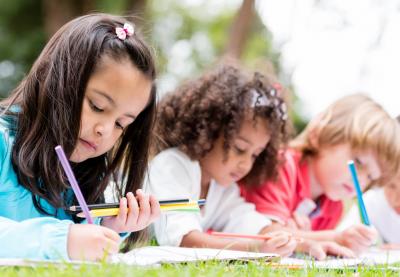Third-grade teacher Kristie Burnett brings meditative practices to her students using class plans, games, emotion regulation, empathetic collaboration and problem solving. By reimaging the role of an educator, she demonstrates how and why to model mindfulness with students.
What inspired you to bring mindfulness practice to the classroom?
I had a boy in my class, Jacob, who … did not stop talking. But I loved him; he was the cutest little thing. … I would redirect him, and I could see on his face he was remorseful about his constant talking.
This student made an impact on me because I thought, “Man, he tries so hard, but he just can’t do it.” I went through the whole year—I didn’t know what to do. … Then, well after the school year was over, I realized that his inability to stop talking was like my brain. It represented my anxiety and my inability to quiet my mind.
I remember running back to my house [and] Googling “how to teach silence.” I thought, “How can little Jacob be silent if I don’t know how to teach it to him?” That’s when I started going on silent retreats. Once the seed was planted, I was able to own it and make it work. That was about five years ago.
What does your mindfulness practice look like as you engage with students in your classroom?
I incorporate rituals into our daily life. Every day when the kids first come in, I have music playing. The kids know that it’s their time to talk to each other. It’s also my time to make face time with every single child, so that they know that I see them, so they feel that their teacher cares.
I quiet students’ minds by guiding their day through themes. I use these themes to quiet the space.
Every Monday we have “Mix It Up Monday,” which I borrowed from Teaching Tolerance. The kids have to sit, play, eat, ... do anything new with a different classmate.
Tuesday is “Tune in Tuesday,” where we tune in to the words we use, the words we hear, the sounds we hear, the movements we make, the way our feet touch the ground.
Wednesday is “Whoopsie Wednesday,” which is about celebrating our mistakes (since I make 80 billion mistakes a day). That’s also when we do confessions. We sit in a circle and go around, and we make a confession. I’ll model and say, “I used a really unkind tone with my husband,” for example. At the end we all bow to whoever made the confession. Most of them are pretty natural: “I lied to my mother,” or, “I slammed the door on my brother’s finger and lied about it.”
One student told us he stole three dollars from the church because his mother was complaining about money. The student watched his mother stress over money, so he went to church and stole three dollars. But we vowed not to react, so we just bowed.
The act of being able to share without others judging or reacting is a beautiful thing. It builds trust. It builds a sense of significance. My kids think, “I can say anything calmly right now in a really tender way, even if it’s wrong, and not get in trouble for it.”
How has your practice affected your students?
I’m getting some of my students to use a kinder tone when they say what they want, think and feel. I’m getting Daniel to trust me, so that when he’s angry he can ask, “Can I go cool off?” And when he comes back, he knows I’m not going to attack him or react. He knows I’m going to hold a calm space where he can decompress. With the high-challenge kids, I’m seeing a tremendous amount of improvement.
I tell the kids, “Right now is the hardest time, right when you’re in your emotions. If you’re really angry, right now is the hardest but best time to try to change it because that’s when the habit is big. Right now, in this very moment, you have an opportunity, Daniel, to feel your anger and watch it pass away.” He’ll be like, “Whoooaaa.”
How has your teaching transformed your mindfulness practice?
I have to be calm. I have to be mindful of everyone in that room so that I can see it all, so that I can catch it in the moment. I have moments in the classroom where I remember my breath, where I remember to find my compassionate heart.
To me, mindfulness is making people aware of relationships. We need to teach how to be in community. Teaching kids how to interact with each other, how to interact with authority. That to me defines mindfulness. I don’t look at just content as the most important thing in my classroom. I also want these 18 kids to live kindly and proactively and show … compassion as a community.
What do educators need to know in order to replicate these strategies?
I don’t feel there is anything I am doing that is really intelligent. I don’t see it like that. But it does require reflection. You have to contemplate. For me, contemplative practice is really where the heart of life is. It’s in quieting the mind, being silent, doing deep listening, journaling, being under the stars, dancing. To me, that’s all contemplative work.
Ehrenhalt is the school-based programming and grants manager with Teaching Tolerance.


0 COMMENTS